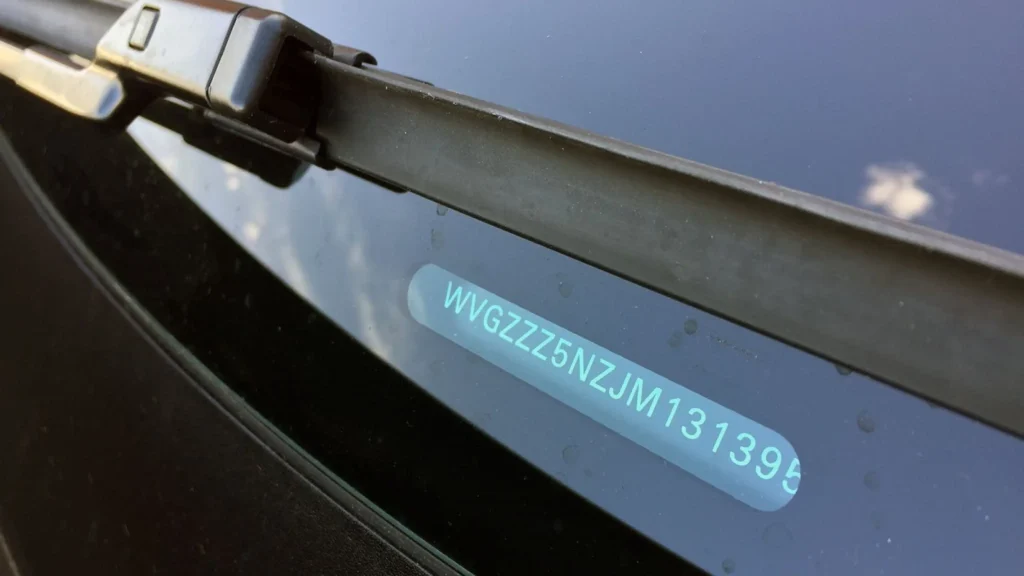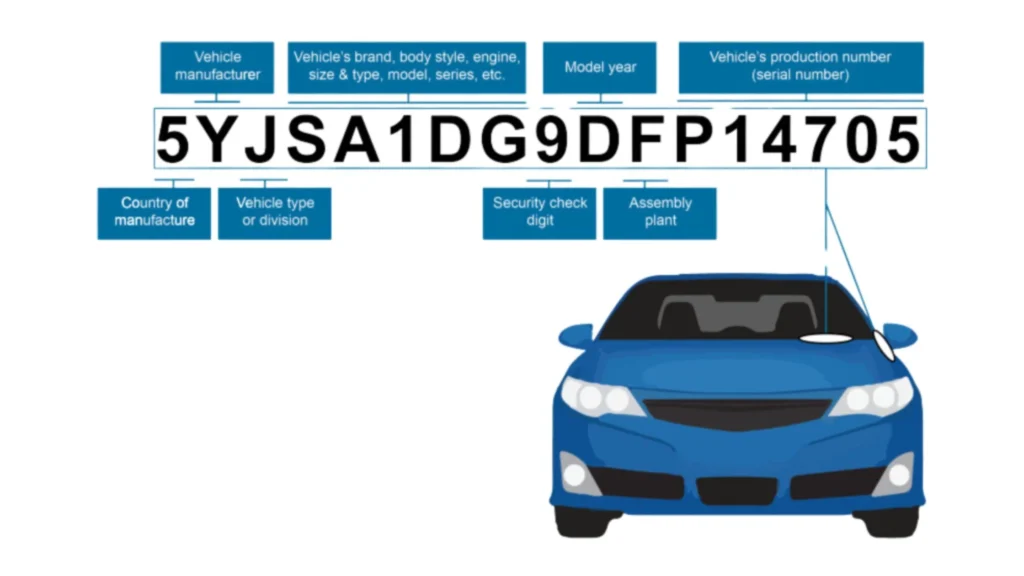When picking a car, we may glance at the paint job, under the hood specs, fuel usage, and special features. Yet, numbers like the Engine Number, Chassis Number, and Vehicle Identification Number (VIN) might not make our checklist when buying a new or pre-loved car. But, what if you could tell a vehicle’s age, like a six month or a year old car, using these digits? They act like a car’s unique DNA. Locating these numbers can seem like a quest, though. Let’s find the hiding spots for your car’s Chassis Number, VIN, and Engine Number together.
What Is the Chassis Number?
Chassis number, which first known as the VIN (vehicle identification quantity), serves to every car version as a kind of unique identifier. On the alternative, we can see that its type of like every other fingerprint of a vehicle, and, very crucial, it offers us the details about automobile manufacturer, model, year of manufacture, other specifications, and so forth.
VINs usually have 17 digits and numbers, and most usually you may locate them both on the dashboard next to the windshield, the driver’s door jamb, or the vehicle’s registration file similarly to being covered on the automobile registration receipt. This is precisely the records wished so that it might be useful in many uses of like registering the vehicle, repairing it, and tracking its history.
How To Spot A Vehicle Identification Number (VIN)?

VIN (Vehicle Identification Number) will provide any necessary information regarding the particular car. This is why where the VIN is found in the car is critical. It includes critical information concerning the car manufacturer, model, and other additions. Whether you register a car, perform transactions, or your vehicle requires coverage, the VIN comes in handy. Here are some commonly found locations for the VIN on a car:
1. Registration Certificate
The local RTO is the first step in vehicle registration as the car dealer carries out the registration after a customer purchases a car. Throughout the process of this printing, the RTO will imprint the number of your vehicle’s chassis on your vehicle’s Registration Certificate (RC). Information about the vehicle is documented on the smart card, which contains various details, ensuring accurate identification and legal documentation.
2. Dashboard
Some producers use the VIN number on the dashboard, usually placed on the driver’s side. Still, the availability of this feature depends on the model. It is usually found close to the windshield, so that it can be sighted easily.
3. Door
It is usually printed on a metal strip located on the B-pillar of the driver’s side door, visible when the door is opened. The location provides a convenient reference point for entering and exiting the vehicle.
Hood: You can find the VIN stamped onto the vehicle under the hood, beside the engine. It is usually located near the front of the engine compartment or on the firewall. Having the VIN in this location makes maintenance and repair easier.
4. Boot
You can usually find the chassis number beneath the spare wheel in the boot when you lift it. A location like this ensures the VIN is protected from the elements while remaining easily accessible for inspection.
Rear Wheel: The serial number on a vehicle in some cars is above the rear wheel but you may struggle to locate it. According to the vehicle brand and model, the location of the information differs.x
5. Car Dealership
In order to get the identification number of the chassis or VIN, go to the dealership where the car was purchased. The presence of vehicle papers and record helps in accessing the VIN in the event that it is not available elsewhere.
6. Insurance Policy Document
When your car insurance policy is issued or renewed, insurers usually send you an email containing your VIN number. Documents like this serve as proof of insurance and contain important information about the insured vehicle.
7. Front Grille
Certain manufacturers or models might print the chassis number or VIN under the front grille, but this is not universal. It depends on the vehicle’s design and the preferences of the manufacturer where this location is located.
Identifying the VIN efficiently is crucial for many administrative and legal purposes, such as maintaining, insuring, and reselling the vehicle.
Decode Vehicle Identification Number (VIN)

These 17 digits represent important statistics about your car. Here is information about each VIN:
- First Digit: The location where the car was manufactured.
- Second and Third Digit: The manufacturer’s details.
- Fourth to Eighth Digits: A description of the car’s brand, engine type, engine capacity, and fuel type.
- Ninth Digit: A security code provided by the manufacturer of the vehicle.
- Tenth Digit: The year the car was manufactured.
- Eleventh Digit: The model’s manufacturing plant.
- Remaining Six Digits: The car’s unique serial number.
*Please note that the above chassis number decoding does not apply to all car manufacturers. It is a generic decode that most manufacturers follow.
Where Can I Find Engine Number of My Car?
Vehicle engine’s number is often stamped on the engine casing. Just as the chassis identification, this mark represents a unique vehicle. An engine number is commonly present on the casing of car engines. Like the chassis variety does, it is used to discover the automobile uniquely. Both the VIN (Vehicle Identification Number) or the Chassis Number and the Engine Number, are two very specific; yet, different characteristics that are unique to each single car. Here is the way to find it:
1. Engine
In most cars, the engine number is located on the engine body. For easy and quick identification car manufacturers insert it on a sticker that’s made of metal which is neatly located on a car’s hood.
2. Registration Certificate
The engine number of the vehicle is labeled when it is registered in the designated Regional Transport Office (RTO) and has its registration certificate printed beforehand. It contains essential details about the vehicle, including its engine number.
3. Insurance Policy Document
Both the engine number and the chassis number are included in your vehicle insurance policy document provided by insurtech companies. A copy of this document is usually sent to your email immediately upon purchase or renewal of your insurance, providing easy access to your car’s engine number.
4. Car Dealership
You can obtain your vehicle’s engine number by calling your car dealership or visiting them in person. A vehicle’s records are accessible to them, and they can provide the necessary information.
5. Owner’s Manual
Generally, a cars manufacturer put an engine number on an engine block with the location of it might be different from model to model. The most detailed guide you get on locating your car’s engine number is in the owner’s manual.
How To Get Your Vehicle Details Online
A national registration system has been introduced by the Ministry of Road Transport and Highways called VAHAN. A vehicle registration registry allows users to access information about their vehicles online. The website, however, restricts access to the full engine and chassis numbers in order to safeguard personal information.
You can check vehicle details by using the chassis number as follows:
- Refer to VAHAN official website.
- Choose ‘Know Your Vehicle Details’ choice from the top menu.
- As soon as the prompt is given, please give your car’s registration number.
- Enter the Captcha code for authentication.
- Go to ‘Search Vehicle’.
Besides securing a travel insurance for your trips, verify that the auto information shown is correct. An all-encompassing policy implies you have cover during your traveling knowing well that you are protected as you move around.
Also Read 14 Different Types of Car Sensors and Their Functions
Conclusion
In conclusion, understanding and locating key vehicle identifiers like the Chassis Number, Vehicle Identification Number (VIN), and Engine Number is crucial for many administrative, legal, and maintenance purposes. These numbers act as a unique fingerprint for every vehicle, ensuring secure registration, smooth transactions, and efficient maintenance. The VIN, found in various parts of the car, decodes essential information like the car’s manufacturer, model, engine type, and year of manufacture. Similarly, the engine number serves as a unique identifier for the car’s engine, which is vital for tracking its history.
Locating these identifiers can be done through various means, such as checking the registration certificate, insurance policy documents, car dealership records, and the vehicle itself in areas like the dashboard, door jamb, engine compartment, and boot. Moreover, tools like the VAHAN registration system allow you to retrieve basic vehicle details online for further verification.
By knowing where to find these numbers and understanding their importance, you ensure your vehicle’s legitimacy, which plays an essential role when selling, insuring, or registering the vehicle. These identifiers offer a level of transparency and security, making them essential components in the lifecycle of any vehicle.
FAQs on Chassis Number and VIN
Are the VIN number and chassis number the same?
Yes, The chassis number and Vehicle Identification Number (VIN) of the car are the same.
Do chassis numbers have 17 digits?
The Vehicle Identification Number (VIN) is made up of 17 characters, both digits and capital letters, and serves as a distinctive marker for the vehicle. It details the car’s specific features, specifications, and manufacturer. The 17-digit VIN format is the most common and has become the standard for vehicles manufactured since January 1981. However, older vehicles may have chassis numbers with fewer than 5 digits or as many as 13.
Is it possible to check the chassis number online?
To check the chassis number online, visit the VAHAN website. You must provide your registered mobile number and email address in order to register on the national portal. When you have completed the registration process, enter your vehicle number to check its chassis number online.









